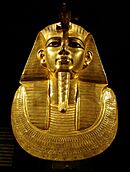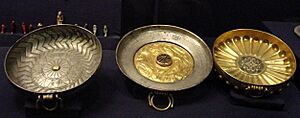Pierre Montet facts for kids
Jean Pierre Marie Montet (born June 27, 1885 – died June 19, 1966) was a famous French Egyptologist. An Egyptologist is a person who studies ancient Egypt.
Contents
About Pierre Montet
Pierre Montet was born in Villefranche-sur-Saône, a town in France. He started his studies at the University of Lyon, where he learned from a teacher named Victor Loret.
Montet worked on digging up ancient sites in Byblos, Lebanon, from 1921 to 1924. There, he found tombs of rulers from the Middle Kingdom period.
Discoveries in Egypt
Between 1929 and 1939, Montet led excavations in Tanis, Egypt. He discovered the royal burial ground, or necropolis, of the Twenty-first and Twenty-second Dynasties. These finds were almost as amazing as the discovery of Tutankhamun's tomb in the Valley of the Kings.
In 1939 and 1940, Montet made a huge discovery. He found the completely untouched tombs of three Egyptian pharaohs at Tanis. These pharaohs were Psusennes I, Amenemope, and Shoshenq II. He also found the tomb of Takelot I, but some items had been taken from it. This tomb still held a gold bracelet that belonged to Osorkon I, Takelot's father. It also had a special heart scarab.
Montet also found the tomb of Osorkon II, which had been completely emptied. He also found the tomb of Prince Hornakht, Osorkon II's son, which was partly plundered.
Work During and After the War
The start of World War II in May 1940 stopped all excavation work in Egypt. However, after the war ended, Montet returned to Tanis. In 1946, he uncovered the untouched tomb of General Wendjebauendjed. This general was the Commander-in-Chief of the Army under Pharaoh Psusennes I.
During his career, Pierre Montet was a professor of Egyptology. He taught at the University of Strasbourg from 1919 to 1948. Then, he taught at the Collège de France in Paris from 1948 to 1956. He passed away in Paris on June 19, 1966.
Montet's Legacy
Montet believed that his excavations at Tanis had found the ancient city of Pi-Ramesses. After he died, another Egyptologist named Manfred Bietak made a new discovery. Bietak found that while Montet had indeed found stones and parts of Pi-Ramesses at Tanis, the real location of the ancient city was about 30 kilometers (18 miles) to the south.
However, Montet is still known for finding the "moved" city of Pi-Ramesses. This means that the people of ancient Egypt had moved parts of the old city to build the new one at Tanis.
Books by Pierre Montet
- Byblos et l'Egypte, quatre campagnes de fouilles à Byblos (1928)
- La Necropole Royale de Tanis (1958)
- Everyday Life in the Days of Ramesses the Great (1958)
- Eternal Egypt (1964)
- Tanis, douze années de fouilles dans une capitale oubliée du delta Égyptien (1942) (This means 'Tanis, Twelve Years of Excavations in a Forgotten Capital of the Egyptian Delta')
See also
 In Spanish: Pierre Montet para niños
In Spanish: Pierre Montet para niños




